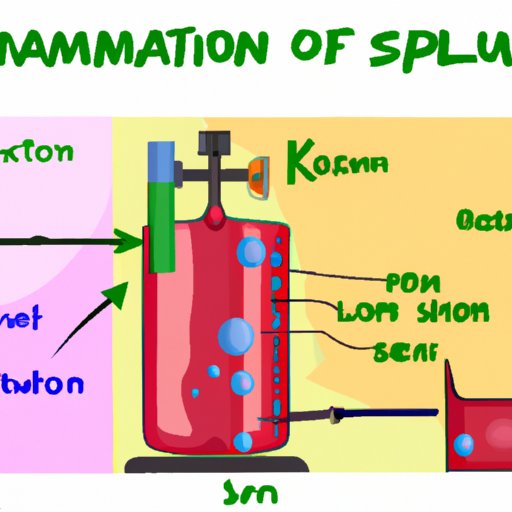An Overview of the Sodium-Potassium Pump
The sodium-potassium pump is a vital cellular mechanism that is responsible for maintaining the balance of sodium and potassium ions within cells. It is also known as the Na+/K+ ATPase, which stands for the “sodium-potassium adenosine triphosphatase” enzyme. The sodium-potassium pump plays an important role in the functioning of all cells, including nerve cells, muscle cells, and other types of cells.
Definition of the Sodium-Potassium Pump
The sodium-potassium pump is an active transport mechanism that uses energy from adenosine triphosphate (ATP) to move sodium and potassium ions across cell membranes. The pump is made up of two proteins, one that binds to sodium ions, and another that binds to potassium ions. As the pump moves these ions across the cell membrane, it creates an electrochemical gradient that is essential for the proper functioning of cells.
Explanation of How the Sodium-Potassium Pump Works
The sodium-potassium pump works by transporting three sodium ions out of the cell in exchange for two potassium ions entering the cell. This exchange of ions creates an electrochemical gradient across the cell membrane. The sodium-potassium pump then uses the energy from ATP to maintain this gradient.
Understanding the Mechanics of the Sodium-Potassium Pump
Exploring the Role of Ions in the Sodium-Potassium Pump
Ions are atoms or molecules that have either gained or lost electrons, giving them a charge. Sodium and potassium ions are essential for the functioning of cells because they help to regulate the electrical potential of the cell membrane. The sodium-potassium pump is responsible for the movement of these ions across the cell membrane, which helps to maintain the electrical potential of the cell.
Examining the Structure and Function of the Sodium-Potassium Pump
The sodium-potassium pump is composed of several different parts, including two proteins, a membrane-spanning portion, and an ATP-binding site. The two proteins are responsible for binding to the sodium and potassium ions, while the membrane-spanning portion allows the pump to move the ions across the cell membrane. The ATP-binding site is responsible for providing energy for the pump to work.
Explaining the Role of the Sodium-Potassium Pump in Cells
Examining the Significance of the Sodium-Potassium Pump
The sodium-potassium pump is essential for the functioning of cells because it helps to maintain the correct balance of ions inside the cell. This is necessary for the proper functioning of many cellular processes, such as nerve impulse transmission, muscle contraction, and other cellular activities. Without the sodium-potassium pump, cells would not be able to properly carry out these processes.
Investigating the Different Types of Sodium-Potassium Pumps
There are several different types of sodium-potassium pumps, each of which has a specific function. For example, there are pumps that are involved in nerve impulse transmission, pumps that are involved in muscle contraction, and pumps that are involved in other cellular activities.
Analyzing the Role of Ions in the Sodium-Potassium Pump
Ions play an important role in the sodium-potassium pump because they are responsible for creating the electrochemical gradient that is necessary for the pump to work. As the pump moves sodium and potassium ions across the cell membrane, it creates an electrochemical gradient that is essential for the proper functioning of cells.
Conclusion
The sodium-potassium pump is a vital cellular mechanism that is responsible for maintaining the balance of sodium and potassium ions within cells. It is composed of two proteins, a membrane-spanning portion, and an ATP-binding site, and utilizes energy from ATP to move sodium and potassium ions across the cell membrane. The movement of these ions creates an electrochemical gradient that is essential for the proper functioning of cells. Understanding the mechanics of the sodium-potassium pump is essential for understanding how cells work and how they can be manipulated to achieve desired outcomes.
(Note: Is this article not meeting your expectations? Do you have knowledge or insights to share? Unlock new opportunities and expand your reach by joining our authors team. Click Registration to join us and share your expertise with our readers.)
